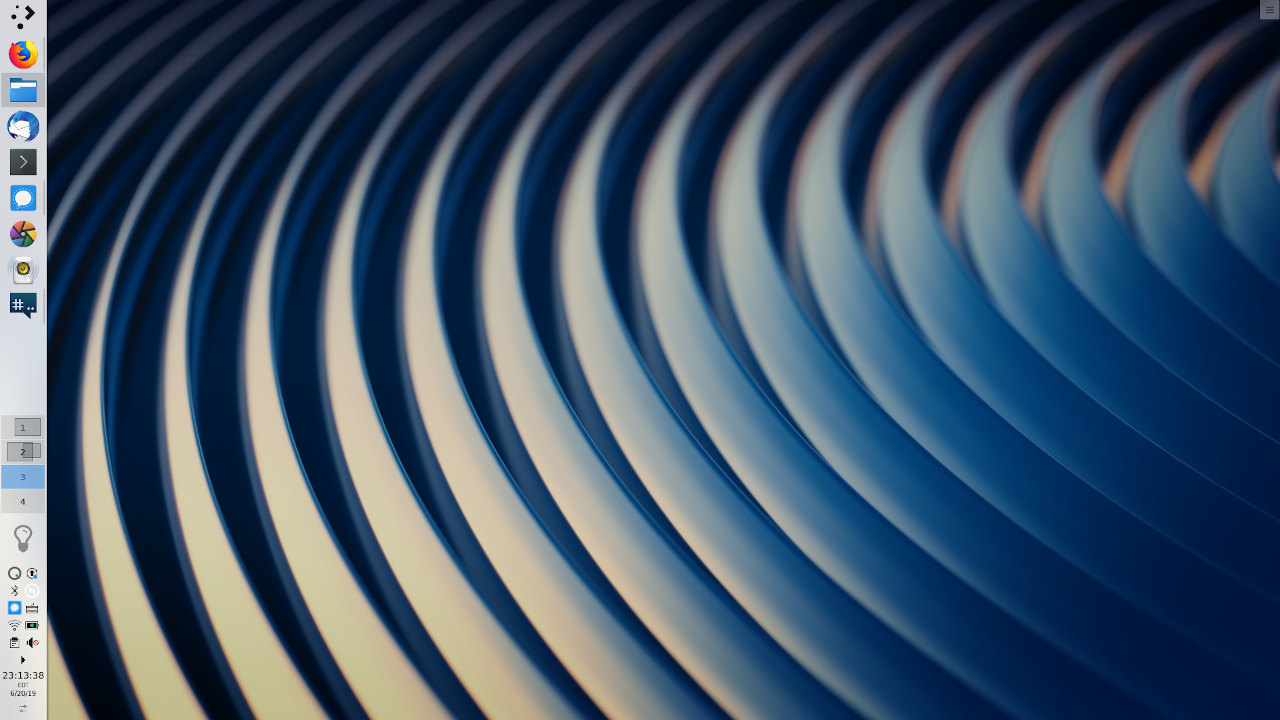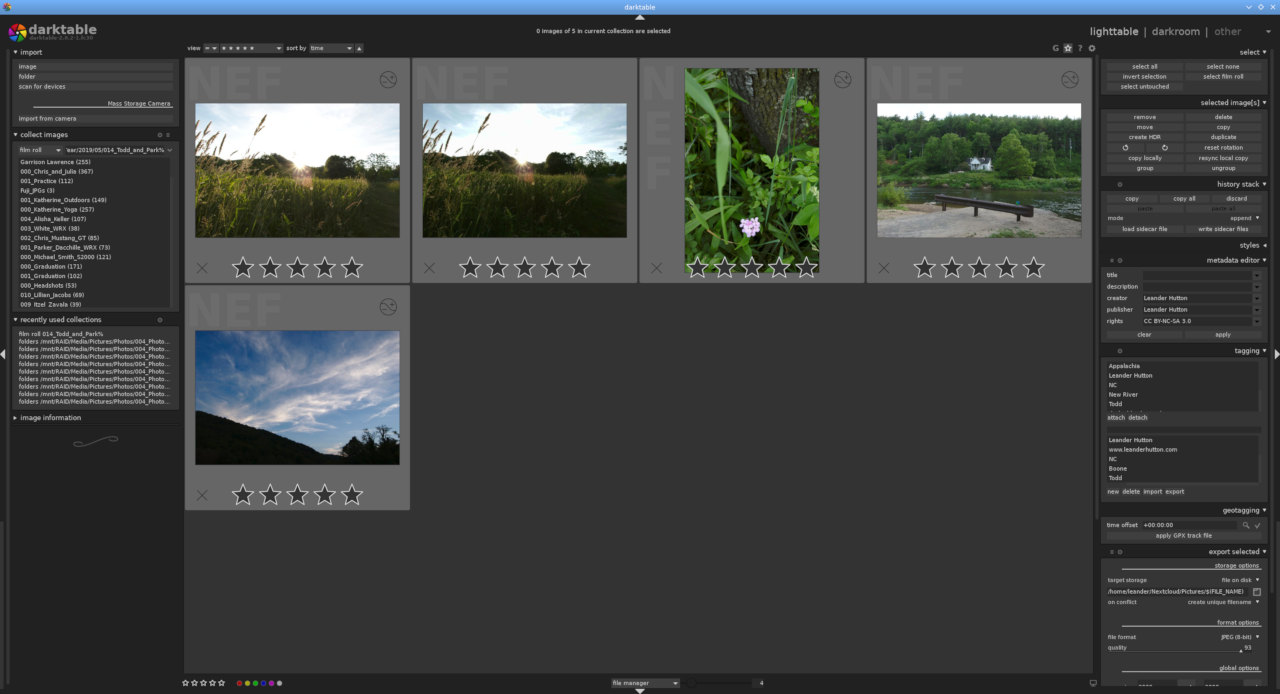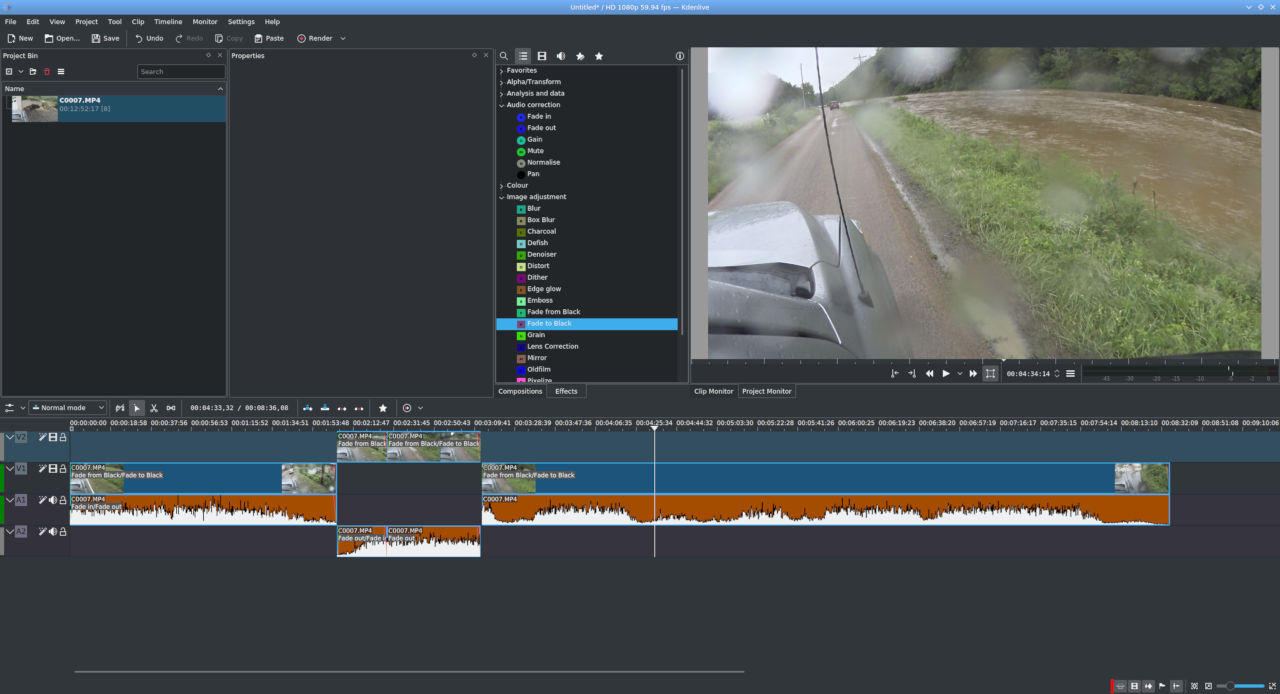Linux Desktop Update
It's been a few years since I've become full time Linux user for my photo and media work flow. As we're now in the sixth month of 2019 I thought it'd be a good time to do a quick update and report on how things are going. When I decided to move off OS X for my photography and video work in 2015 the landscape was quite different. I was a seasoned Linux user and admin at the time but had kept Macs around for access to Adobe and Apple programs. But things change, the libre software options were getting better and I was mostly tired of giving Adobe money and to a lesser extent Apple. Keep in mind this was before Apple released the unreliable, throttling, terrible keyboard having and consumable current generation MacBook Pro. If I wasn't set on switching before then those things alone would have sealed the deal. Before then I was less hostile toward Apple's product line.

I still have a 2015 MacBook Pro in the house but I mostly use it for two things: my Canon Pro 100 printer and Epson V600 scanner. I have a what is now ancient copy of Photoshop CS6 and Lightroom 5.7 on it that haven't seen any use in a very long time either. My primary machines these days are an AMD Threadripper desktop and a Dell Precision laptop, both have only Fedora Linux installed on them. No dual booting, no Windows 10 virtual machines, no “cheating” if you could call it that. Honestly don’t think I could be all that useful in a Windows environment these days.
Just laying my cards here on the table from the beginning so no one see a Mac in my presence and thinks I’m making this all up.
Now then, in the intervening years the Linux desktop has improved dramatically. KDE Plasma has become my go to desktop environment for two main reasons. First of all when I picked up the Precision I needed something that did HiDPi scaling reasonably well. This forced me off XFCE and got me comparing GNOME3 and KDE Plasma 5 desktop environments. I know a lot of people like i3 Gaps or MATE or whatever but IMO there's a lot of good reasons to stick with the major players if you're looking to just get things done. Plus if I was going to show normal people how "full featured" the Linux desktop had become some sort of super tweaky desktop made for posting screenshots to /g/ or Reddit was out of the question. My wife should be able to pick up my machine and use with without much fuss. Plasma and GNOME look and act like modern desktops so that's the route I went. I ultimately decided on KDE Plasma 5 since it supported fractional scaling and my Precision looks best at 1.5-1.6x. GNOME3 on the other hand has a stinky foot for a mascot and could only do full integer scaling at the time. I think they've added the fractional scaling as a test feature in one of the latest releases however. Not to mention the difference in resource usage between the two. I really wanted to like GNOME3 since they did something actually brave and different with the desktop interface but it was lacking too many features, broke a lot and ate CPU and RAM like crazy. Plasma 5 on the other hand runs on everything from my super old Latitude E4200 with 3GB of RAM to my Threadripper with 64GB.
The KDE folks have really been hitting it out of the park the last few years with their releases of the Plasmas desktop, as long as you don’t need any accessibility features. GNOME3 is still the only desktop doing serious work on that front. The integrated applications for KDE are a different story too and tend to vary on quality. Gwenview has been great and Okular is the best PDF application out there today IMO. Konsole has become my favorite terminal emulator as well. However KMail is an unusable train wreck. I imagine the resources put into it aren't the greatest as most Linux users are probably going to use Thunderbird, mutt, alpine or a webmail interface.
On the distribution side of things I've mostly stuck to Fedora and Debian. I've been a long time Debian user as it covers a lot of use cases very well, is extremely stable and I'm rather fond of their governance structure. Plus it's dead simple to move from one release to the next. Fedora has made some significant strides in this direction lately and like their "cutting edge adjacent" strategy in terms of software versions. The last time I used Fedora for anything was the Fedora Core 4 through about the Fedora 8 days. After then it went through some shakey periods in terms of stability and usability but nowadays I'd say it's easier to get up and going with than Ubuntu. Fedora's KDE spin is quite nice as well, despite being known as "the GNOME distro." My go to machines for photo and video work are all running Fedora right now and I have a couple of desktop and laptops on Debian, all of my infrastructure stuff runs Debian too. IMO you can't really go wrong with either and if you want to get started with Linux I'd try Fedora, especially if you're a first time Linux user. I'm not a fan of derivative distributions and I've always found some of Ubuntu's choices to be strange, just skip those and go straight for Debian Stable IMO.

On the less day to day bread and butter desktop stuff and more image work flow side I'm continually impressed with Darktable. I don't miss Lightroom in the slightest. I started moving over to Fuji about the same time as I moved to Darktable and it has handled the RAW files nicely. From what I understand until recently Lightroom struggled with the RAF format and making effective use of X-trans, Iridient Developer seems to be more popular with Fuji users on Mac and Windows but I find Darktable’s RAF conversion to be quite fantastic. Indeed others seem to agree with my sentiment. Even if you’re stuck using a Mac or Windows machine I’d suggest trying out Darktable for Fuji RAW conversion. For the rest of the digital asset management workflow Darktable has been more than adequate, it does have more of a learning curve than Lightroom but it also allows for more under-the-hood exploration with modules like equalizer. I tend to be pretty self reliant on the organizing files front on my disks though and have heard other’s coming from things like Aperture and iPhoto saying Darktable doesn’t do enough on that front. The developers have stated time and again they aren’t writing a file manager and there are other better solutions out there for it. Personally I think it’s fine, but if you’re used to just dumping you files at a library management program and letting it handle the files on disk it will be an adjustment. Honestly I don’t like that approach as it locks your organizational structure into that piece of software and I’d rather just have the files available to me in a directory structure to move about as I see fit.
The GIMP has changed some since I first moved over, but in general it’s slower moving than most software package development cycles these days. There seems to be two camps for GIMP users: it’s adequate or it’s a piece of junk. Where you land largely seems to be dependent on what you’re trying to do and in my opinion photographers are better served in the GIMP than designers. Most people I see complaining about it lacking features are designers and print production types. Which is fair, GIMP does lack CMYK mode among other things and there is an adjustment to be made coming form Adobe land. For my needs it still gets the job done especially now that 16-bit and 32-bit images are supported in 2.10. Before then I was running the unstable testing branch as 2.8 only supported 8-bit images. If you only working with JPEGs this isn't a big deal. It only matters when you're working with TIFFs and RAW file derivatives. If all you need is minor retouching there's no reason to use Photoshop, unless you need a specific feature or work with others in a Adobe centric environment. But for most of us just working with ourselves out here GIMP seems to get the job done.

Video editing is something that has changed massively since 2015. When I first moved my media production efforts to Linux there wasn’t a good option for a non-linear editor so I dual booted and used Sony Vegas or just got out the MacBook Pro for iMovie, Final Cut or QuickTime. That is no longer the case. Kdenlive has made massive strives and recently did a huge refactoring release that squished a lot of long standing odd behaviors, but I’ve been using it since 2017 without many complaints. If you’re used to old-school iMovie and Final Cut the Kdenlive is pretty easy to move around in. I’ve heard some folks say it’s similar to Adobe Premiere as well.
I am still glad I made the complete switchover, even before this I was fine with Linux as a desktop operating system. However now I have moved my comfort zone with it and I’m no longer at the whims of a couple of rather controlling companies for the creative part of my life. I really don’t like feeding anti-competitive, monopolistic, end-user hostile companies trying to squeeze blood from a stone with monthly subscriptions or engineered to fail overly delicate status symbols.
I’ve also come to despise the term “industry standard” as it seems to just be a good excuse to not try to move outside the box you were taught to stay in. “You get what you pay for” is another terrible motto and seems to be used by these corporate types to put down libre software alternatives on a regular basis, but I’m off on a tangent at this point but I’d suggest trying some of these tools. There are even more applications I have not covered here like Krita and Raw Therapee, both of which I've been using lately as well. It really is about the best time it’s even been to jettison the likes of Adobe, Apple, Google or Microsoft these days. Depending on what exactly your need is and what products you wish to avoid. In the case of most of us just working on creative photo and video fields by ourselves or for ourselves it’s really just about overcoming the inertia that Adobe has in this space.
Even professionally it's more than possible, but like switching camera systems there is an initial time cost and you have to decide if the benefits are worth it. In my opinion the freedom is worth trouble and my work hasn't suffered for it. Just don't let others saying "oh, that's not for anyone doing serious work" discourage you. I just don't think that being on a corporate leash is the only way to get things done.